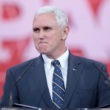SPENDING A WEEK IN THE TOWN where Sarah Palin began her political career helped me understand why Palin is a near perfect candidate for the vice presidency—even if her two terms as mayor of Wasilla and twenty months as governor of Alaska are disgracefully inadequate preparation for the office itself.
The Palin nomination speaks to the Republican base, which was unenthusiastic about a John McCain presidency and fuming over the prospect of Connecticut Senator Joe Lieberman as McCain’s running mate. Conservatives, in particular the Christian extremists, without whom the Republican Party cannot win national elections, understand that Palin is a battle-tested cultural warrior.
“Values voters” turned out by the culture wars elected George W. Bush and kept the Republicans in control of Congress until 2006, when a very real war in Iraq, the administration’s failed response to Hurricane Katrina, and corruption and a gay (and pedophiliac) sex scandal in the Republican House turned a national majority against the Republican Party. With the nomination of Sarah Palin, John McCain is trying to call the culture warriors back into the fight.
Palin’s culture-war bona fides were established by what was perhaps the most divisive mayoral campaign ever conducted in Wasilla, Alaska (pop. 4,800 when Palin took office in 1997), and by her contentious first term as mayor.
In 1996, Palin challenged Mayor John Stein, who had a background in city planning and had held office for nine years. According to Wasilla resident and voter registrar Anne Kilkenny, Stein “was ahead of the curve and took city government seriously.” Wasilla was growing, and the mayor had focused on zoning ordinances, new drain-field specifications for property owners whose septic tanks were polluting local lakes, grading and paving roads, and assigning police officers to the town’s public schools.
In an interview in Wasilla, Kilkenny said that Stein’s administration was “perhaps more strict and more organizational than the people in this small town were ready for.” Stein and the City Council he directed tended to be “legal and legalistic”—and probably were not political enough to cultivate good relations with voters.
Kilkenny is a longtime resident of Wasilla, where she became involved in city politics after the public works department raised questions about her driveway when her street was being paved for the first time. Kilkenny began collaborating with civil engineers on a pro bono rewrite of a section of the city code, and carefully watching the City Council.
A few days after John McCain selected Palin as his running mate, Kilkenny wrote a cogent critique of her former mayor and e-mailed it to a few friends. The e-mail went viral, and by the time I spoke to her during the second week of September, Kilkenny had received some 9,600 e-mail responses and had done twenty-four interviews with reporters.
Stein had recruited Palin to run for the City Council four years before she challenged him, introducing her to civic leaders and predicting that she would make a strong member of the Council. He had no idea what was coming.
Wasilla, at the time, was a town so small that everyone knew everyone else’s political affiliation but no one ran for office as a Republican or a Democrat. In 1996, Sarah Palin ran the first partisan mayoral race in Wasilla’s history. Palin announced her campaign with a full-page ad in the local newspaper, which featured a photo of her standing with four local Republican legislators endorsing her candidacy. It was an unprecedented intrusion of statewide partisan politics into what until then had been non-partisan municipal elections.
Palin’s campaign was more than partisan. It took a page from the Karl Rove culture-wars playbook, which had made George W. Bush governor of Texas in 1994. Palin focused on issues foreign to municipal government, in particular the Second Amendment. Every ad her campaign placed in theMat-Su Valley Frontiersman included the tagline “Endorsed by the NRA.” Palin regularly introduced herself as “a lifelong NRA member.”
There are 2,800 NRA members in Wasilla, and Alaska has the highest per capita gun ownership in the nation. Alaskan politicians know better than to run against gun owners. Stein didn’t take on Wasilla’s gun owners, so he was surprised to learn that Palin’s supporters were going door to door, warning prospective voters that their mayor wanted to “melt down all the guns in the state.”
Palin dismissed Stein’s public complaints about her supporters. “I’m the only one campaigning on my behalf,” she told the Frontiersman.
Despite Stein’s protestations, the “values campaign” continued. Palin supporters told prospective voters that their candidate was a Christian, and it was time for Wasilla to elect a Christian mayor, according to a journalist who covered the campaign. (Stein is also a Christian, although his surname might have led some voters to believe that he was a Jew.) Palin supporters also asked why Stein’s wife’s last name was not the same as his.
Stein complained that the Palin campaign was focused on gun control, abortion, and fabricated claims that he intended to raise taxes to fund halfway houses he was planning to locate in residential neighborhoods. “I wish politics was like sports, with rules on ethics and referees that make decisions,” Stein told the Frontiersman. “The issues that swayed this campaign didn’t relate to real life in Wasilla.”
Wasilla’s voters, however, related to the issues. Palin’s God and Guns campaign increased turnout from the 14 percent that was predicted to 32 percent. She defeated Stein by a vote of 616 to 413.
DADDY’S ROOMMATE?—In office, Sarah Palin would govern as she had run, as a hard partisan focused on issues that appealed to the religious right. Ridding the city library of books that offended the sensibilities of religious conservatives was one such issue.
Palin had campaigned against a mayor and city officials she claimed were unresponsive to the residents of Wasilla. She promised that “city department heads will have clear directions to serve you, not my personal gains.”
Shortly after she was elected, Palin began meeting with the department heads to discuss her plans and their future. She said she would not “touch a city employee’s pay or their jobs.” Yet it was evident that firings were coming. It is in this context that Palin’s attempt to impose censorship on the library must be understood.
As a mayor-elect meeting with city department heads, Palin confronted Wasilla librarian Mary Ellen Emmons. She asked the librarian if she “could live with outright censorship of books,” Emmons told the local media.
“I told her clearly, I will fight anyone who tries to dictate what books can go into the library,” said Emmons shortly after meeting with Palin. “She asked if I would object to censorship. ‘Yup,’ I said. And I told her it would not be just me. This was a constitutional question and the American Civil Liberties Union would get involved, too.”
Again, context is important. The mayor was asking the librarian about censorship at a time when the librarian knew her job was on the line. Emmons was also aware of a censorship campaign already under way in Wasilla. Self-appointed Christian-right censors were removing books from library shelves and tearing out or redacting passages, pages, and chapters they found offensive, said a Wasilla resident who had supported the librarian. The account was confirmed by a New York Times story that identified one title that Palin herself complained about when she was a Council member. According to the Times, Palin told colleagues that Daddy’s Roommate, a book that helps children understand homosexuality, did not belong in the library. Palin had not read the book at the time.
The other five city department heads lost their jobs after Palin demanded they resign and reapply for work with the city, if they were interested. Emmons was the only one to survive the mayor’s first month in office.
“The librarian kept her job because she was beloved in the community,” said Kilkenny. Mary Ellen Emmons had something the public works director didn’t have—a constituency. Firing her would have created problems for Palin. But Emmons’s budget was cut, said a woman who had supported her. “It’s a little complicated. The borough had no money and was cutting budgets,” the woman said of the Matanusa-Susitna Borough council. “Wasilla was rich at the time, but Sarah refused to make up the difference in the library budget.”
Ultimately Emmons moved on. But there is a preponderance of evidence that Sarah Palin used her office to try to move books off the shelves of Wasilla’s public library, despite CNN’s report that it never happened and the McCain campaign’s denial that there was ever any censorship.
While interfering with citizens’ First Amendment rights offends many voters, for the specific group the Palin vice presidential nomination was intended to please, rooting out literature that is deemed offensive for religious reasons is a singular act of courage. Censoring writing that might cast homosexuality in a favorable light is considered even more admirable.
GUNFIGHT AT CITY HALL—Mayor Palin quickly moved from the First to the Second Amendment, rescinding her predecessor’s 1994 directive banning guns from City Hall and other public buildings. The new policy was a giveback to the NRA, but it angered Council member Nick Carney. He introduced an ordinance that would have banned guns from liquor stores, bars, government service buildings, domestic violence shelters, restaurants, theaters, playgrounds, and city parks.
When Carney’s ordinance was on the City Council’s July 1997 agenda, the chamber was filled with opponents, whom supporters of the ordinance insisted were brought in by Palin. Palin’s critics protested that the mayor went out of her way to accommodate the opponents of the ordinance, stretching procedural rules to allow them to speak. According to reporting in the Frontiersman, only one identified himself as a resident of Wasilla. The pro-gun claque was vocal and volatile, with one speaker angrily calling Carney a communist.
Palin denied that she brought the pro-gun group to the Council meeting. But the ordinance failed, and Carney, who was another early Palin promoter and a councilmember known for hard work and attention to detail, earned a permanent place on the mayor’s enemies list.
The other “values voters” issue was group homes and halfway houses, for some reason anathema among fundamentalist Christians in Wasilla. Palin proposed an ordinance that would limit halfway houses and group homes to no more than four residents and would prohibit the location of adult businesses and correctional facilities in the vicinity of churches, schools, and parks.
Dick Deuser, who had served as city attorney for ten years, told the mayor that the U.S. Supreme Court had ruled that such restrictions on group-home occupancy were a violation of the federal Fair Housing Act. The ordinance would never withstand a challenge in court, he explained. Palin responded, “I don’t care what the Supreme Court says!”
Within months, Deuser was gone, replaced by the general counsel of the Alaska Republican Party. The group homes issue was the second time Deuser crossed Palin. In her first Council meeting as mayor, Palin had brought in two lawyers from Anchorage to make the case that she could fill two vacant Council seats without a vote. Deuser blocked the action, which he said was a violation of state law and the city charter. Ultimately, Palin used a complaint from a campaign supporter, who was also a developer, to convince Council members that Deuser had to go, according to the New York Times.
Other than the librarian, the city attorney was the last holdout from John Stein’s administrative team. The forced turnover didn’t worry Palin. “It’s not rocket science,” she said. “It’s $6 million and fifty-three employees.”
If it was not rocket science, it was more than Palin could manage; and she was astute enough to bring in an experienced administrator, John Cramer, who had worked in the governor’s office and was temporarily working in the office of State Senator Lyda Green. Green was a veteran legislator from Wasilla and one of the four statehouse Republicans who had endorsed Palin and helped her start her career.
There was one contradiction in Palin’s family-values administration. Alaska liquor laws require bars to close between 3 and 5 a.m. Before Palin fired longtime Wasilla police chief Irl Stambaugh, he had proposed that bars inside the city limits close at 2:30 a.m. on weekdays and 3 a.m. on Fridays and Saturdays. He had even done some early-morning surveillance in the city’s two bars and provided the Council with an informal survey of the number of drunks he encountered between 3 and 5 a.m.
Palin opposed the ordinance, arguing that with Alaska’s long hours of daylight, many patrons didn’t get off work until after midnight, and she asked that the Council allow bar owners to continue to follow the more liberal state law. A citizen criticizing Palin’s position said the mayor was supporting bar owners who had contributed to her campaign (an assertion that this reporter was unable to verify). The ordinance was defeated by a 3-2 vote, with Palin voting against it.
By the standards of the Christian right, Palin’s first year as mayor was a remarkable success. If fighting to keep the bars open until 5 a.m. offended the evangelicals, most of what Palin did as mayor of Wasilla pleased them. As did her return to Wasilla as governor, to speak to the graduating class of a Christian high school, telling the students that the war in Iraq was God’s plan, as was the gas pipeline she is trying to persuade a Canadian company to build.
SARAH SINKING—There are signs that John McCain’s attempt to serve two masters—the Christian Right and American voters in general—is in trouble.
Fivethirtyeight.com’s Nate Silver reports that Sarah Palin might be losing some of her luster. Silver does some of the most sophisticated and cautious composite analysis of major polls. More often than not he is spot on. Read on:
McCain’s other problem is that Sarah Palin may no longer be an asset to the ticket; in fact, she may be a liability. Averaging the candidates’ favorability scores across four recent polls—as one should always try and do when looking at favorability numbers since they can vary greatly depending on question wording—Palin now has the worst net scores among the four principals in the race.Palin’s average favorability score is now a +7—about 10 points behind Joe Biden’s numbers. Perhaps more importantly, these numbers are 10-15 points behind where Palin’s numbers were just a week or so ago. If voters come in not knowing very much about a candidate—and the more they see of the candidate, the less they like the candidate. This is a major concern.
PALIN VS. GREEN—Lyda Green didn’t endorse Palin in the 2006 Republican gubernatorial primary. But when Palin won the general election, the Senate president from Palin’s hometown was enthusiastic. “Two women from the [Matanusa-Susitna] Valley holding such high offices in Alaska,” Green said. “I assumed we would be working together.” Like Palin, Green is pro-NRA, pro-family, anti-tax, and small-government; so it was a logical, if flawed, assumption.
“There was never any attempt to consult with us,” Green said. “At first I thought it was because she never served in the legislature and didn’t understand how we worked.” Palin relied on her popularity and enlisted several select legislators to promote raising the petroleum profits tax (PPT) and restarting stalled natural gas pipeline negotiations. She succeeded with both measures.
University of Alaska, Fairbanks, political science professor Jerry McBeath said that those two achievements alone are a remarkable record. McBeath said that Palin took a stand for “the sovereignty of the state,” when she increased the PPT and found a third party, TransCanada, to bid on a gas line project the three big “majors” have been dragging out for thirty years. It might be another ten years before any North Slope gas moves through any pipeline, but Palin persuaded the legislature to put $500 million on the table to start a process that eluded governors for thirty years. And increasing the PPT from to 22.5 to 25 percent adds $1.6 billion to Alaska’s $12.3 budget this year.
None of this would have happened if VECO CEO Bill Allen had been in the lobby in Juneau rather than in federal court in Anchorage, said a source involved in state executive politics. Until FBI agents raided VECO’s offices and the homes of the state legislators he was bribing, Allen’s oil-service company was the industry’s muscle in the legislature. With Big Oil impaired, Palin had a free run.
The same executive office source predicted that Palin’s streak might end because the governor has built so few relationships with the legislature. Green agrees, and said that Palin runs a closed administration and is advised by a few associates, many of them friends from high school. And by her husband. “You can govern like that until you run into problems,” Green said.
Recovering from breast cancer at sixty-nine, Green won’t be a problem. She decided not to run against a primary opponent backed by Palin. Palin is not only supporting Green’s primary opponent, Linda Menard. “[Palin’s] father recruited her to run against me,” Green said. “I hear he had to get her to change her party affiliation so she could run as a Republican.” In 1996 Green endorsed Palin and helped her win her first election as mayor of Wasilla.
PALIN NOT SO GREEN—Although Governor Palin opened her doors to a coalition of environmentalists and conservationists, the governor is an environmental hazard:
• Palin helped kill a ballot proposition that would have imposed water quality standards on what will be the largest open-pit gold mine in North America, in the headwaters of Bristol Bay. The proposition required that emissions from the Pebble Mine be non-toxic to fish or humans. Palin came out against the proposition six days before the election in August, ensuring its failure. Her in-laws are commercial fishers in the bay, one of North America’s richest fisheries. Her daughter, Bristol, is named after the bay.
• Palin sued the U.S. government, in an attempt to block the listing of polar bears as an endangered species. She falsely claimed that state agency scientists found no ill effects of global warming on polar bears, and even published an opinion piece in the New York Times making the same argument. University of Alaska professor Rick Steiner obtained e-mails in which Alaska’s state scientists say the bears are in peril because of global warming—after the governor fought the release of the e-mails.
• Alaska is heating up four times faster than the global average and several costal villages, like Shishmaref, home to 500 Inupiaq Eskimos on the Chukchi Sea, are relocating because of rising water and melting ice. Palin opposes policies that would reduce greenhouse gases. She has kept Alaska out of the Western Climate Initiative, which includes every Pacific coastal state (even British Columbia), affiliating only as an observer. “I’m not an Al Gore, doom-and-gloom environmentalist blaming the changes in our climate on human activity,” Palin said in December 2007.






0 Comments